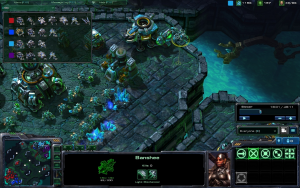The allure of competitive games has grown immensely over the last decade, with the rise of online consoles and better networking platforms, what was once just localized to your nearest arcade has become a major business with real money, players and sponsorship.
As it stands the four big genres of competitive games are: shooters, fighting games, strategy titles and MOBAs. While these four genres offer a huge variety of design and mechanics, there are interesting similarities to look at. And what separates regular games from competitive level games.
Equal Play:
As we’ve talked about in the past: the rise of DLC , free-to- play and micro transactions have been several major changes in both game design and the industry of the last few years.
And while designers have seen the profit that can come from micro transactions, competitive gamers have a strict tolerance of what they will allow.
The biggest no-no is “pay to win” mechanics — where players can receive gameplay boosting abilities or bonuses by spending extra money. Now as many of you are getting ready to point out: “what about League of Legends and DOTA 2?” And yes, both titles base their monetary model on micro transactions; however there is a crucial difference in their model.
The items that cost players real money are separate from the actual game experience. In other words, nothing that directly impacts the gameplay can be bought with money. While League of Legends does have experience boosters that increase the rate of earning currency, that plays into the meta-game and not into the gameplay.
With League of Legends, players can spend both real money and in game currency to permanently unlock new champions and having a stable of champions is important for tournament play. But, having champions and knowing how to play them are two different things. The important point is simply that player skill has to trump spending money, no exception.
Now, taking money out of the game design is a major point but the actual gameplay is just as important.
Set Design:
When we look at sporting events between teams or individuals, one of the most defining factors is symmetry. Both sides have to go in on equal footing with strict limits on equipment. Going back to the previous point on micro transactions, there should be no factor other then player skill that determine the victor.
Game balance, especially competitive game balance is a huge topic and one that we could have entire posts dedicated to each game out there. For this post we’re going to take an overview of game balance.
First off as a given: no handicap features of any kind. That means no auto-aim, in game shortcuts or anything that can be turned on to give one side an advantage.
Now, a game with those features isn’t immediately discounted by competitive gamers if there is a way to turn those features off for competitive play.
Another big point that is exclusive to RTS titles are limiting in-game UI assists like unit tracking, auto construction or anything that can pick up the slack for the player. This in turn led to the focus on micro-oriented RTS titles compared to the macro ones like Supreme Commander and older Command and Conquer games.
Balancing out units, equipment and general play-styles is a huge deal as there must never be a perfect strategy. This is what separates regular multiplayer games from the ones that reach the competitive level as there is a lot of work that goes into game balance. Companies like Blizzard and Riot Games spend an inexhaustible amount of time balancing every aspect of their games down to the decimal point.
While keeping players happy and game’s balanced are major points of the competitive market, in order to sell people on competitive games there is still one factor that needs to be mentioned: showcasing matches.
Spectate Play:
Perhaps the most removed aspect from the gameplay of competitive games is making sure that people can watch the matches being played. In the early days the only ways you were going to watch competition level play was either being at the tournament or hoping someone was recording it and uploaded it.
As the digital age grew in the last decade and the rise of popularity of the competitive scene, game designers wanted to capitalize on their games with better spectator options. At first it was simply the way to record matches through an in game tool and upload it to the internet.
Series like Halo gave players the ability to edit and control footage and gave us the Red vs. Blue web series. As the competitive scene took off in the mid 00s the next step was allowing spectators to watch live gameplay by connecting to the game lobby. This gave crowds of people the excitement of a competition without having to be there.
Advances like watching live play were dependent both on improvements in Internet speed and game netcode. If a game ran into connection issues like lag or dropped games, it would not work in this day and age.

The Halo series was the first exclusive FPS for the consoles that became popular in competitive circles.
Speaking about the Internet, we can’t forget about the simple ability to play games online as a major contributor to the competitive scene.
While MMO and FPS fans were able to enjoy online play thanks to computers, console gamers had to wait for the hardware to catch up. With online play possible both on the PC and console, the decline of the arcade industry did not slow down the competitive game scene.
The latest advance in competitive play was not just allowing people to spectate, but to provide commentary options. Now, instead of just watching the same screen as the participants, fans were treated to color commentary and analytics of a match. With commentary mode, competitive games are beginning to mirror sporting events in terms of allowing people to watch them.
The rise of providing commentaries for games has also led to casters becoming Internet celebrities like Husky and as a way to learn games such as the Day 9 casts for Starcraft 2.
The competitive scene has certainty grown as much as the game industry and with each new game, is becoming more accessible for spectators as much as players. With more developers looking to capitalize on this trend it is important to remember what makes a game popular for competitive gamers.
As the genre grows both in terms of players and spectators, it will be interesting to see games take yet another step into the spotlight. Perhaps someday one of the many ESPN channels will be dedicated to competitive games.



